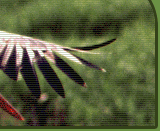| Management plan for Stikli Mires Nature Reserve The expert studies have given new and valuable information about the protected species of EU importance in the project site. This is the largest raised bog complex in the Western Latvia. The especially protected Nature area includes 5 raised bogs, 7 lakes and large forest areas. Plants: Flora of the Nature Reserve has been studied since 1983. In total, 486 vascular plant and 148 bryophyte species are known in the site. The territory holds 28 protected vascular plant species and 25 bryophyte species of Latvia. There are species of Habitats Directive Annex V. Birds: Stikli Mires Nature Reserve can be considered as one of the most prominent sites for bird species in Latvia. In 2003 monitoring of bird species was started. In total in this site 28 species of European importance and protected in Latvia are known. In the forests 15 species of Bird Directive are known, especially the species of Falconiformes (Pandion haliaeetus, Haliaeetus albicilla), Galliformes (Bonasa bonasia, Tetrao urogallus, Tetrao tetrix), Piciformes (Picoides tridactylus, Dryocopus martius) and Strigiformes (Glauccidium passerinum, Aegolius funereus). In the territory of the Nature reserve in the forests of 5 Tetrao urogallus leks are known. In the raised bogs breeds Pluvialis apricaria (14 pairs), Tringa glareola (10 pairs), Grus grus (at least 15 pairs). In the leks of Tetrao tetrix there are about 25 specimens. Invertebrates: In total 21 rare and protected species of Latvia were observed there, from them 2 are of Habitats Directive Annex IV - Coenonympha hero and Lopinga achine. The Annex II species was found outside the territory but could be observed also in the territory in the places where large oaks occur. Mammals: Many typical mammal species of Latvia are known in the territory, from them 4 are protected in Latvia and of European concern - Castor fiber, Lutra lutra and Canis lupus. There is also information about Lynx lynx in the territory. Amphibians: From the Habitats Directive species there are known 2 species - Rana lessonae and Rana arvalis. Habitats: In the mire vegetation raised bog habitats dominate (7110*), part of them are degraded due to drainage. Here occur also transition mires and quaking bogs (7140). In forests there are 3 habitats (9010*, 91D0*, 9080*) of Habitats Directive Annex I that are priority ones. The largest areas cover bog woodlands 91D0*. From the 7 lakes 2 are considered as dystrophic lakes (3160). Factors that negatively influence the territory: 1. Change of the hydrological regime due to the drainage; 2. Invasion of spruce in the Western taiga habitats that is a place for Tetrao urogallus leks; 3. Water level in the lakes has risen due to the activities of Castor fiber; as a result several protected plant species of Latvia Lobelia dortmanna, Isoetes lacustris, Eleocharis multicaulus etc.) have disappeared; 4. Lake eutrophication; 5. Recreation ( berry picking, trampling, waste, danger of fires); 6. Intense forest cutting before 1999 when the protected nature area was established; 7. Ceasing of grassland management, as a result Molinion meadow (6410), has overgrown but it can be restored.
Management actions. In total there are 9 short-term aims for 33 management actions are planned: 1. Maintenance of intact raised bogs without any disturbance ; 2. Maintenance of biologically valuable forests; 3. Restoration of hydrology in Vasenieki Mire by building dams on the drainage ditches, hydrological studies in the site; 4. Restoration of Molinia meadows; 5. Management of 4 Tetrao urogallus leks; 6. Building of a nature trail (2,7 km) and a tower (6 m), topographical and geological studies along the route of the nature trail; 7. Setting of information signs and boards; 8. Publishing of informative materials about the site; 9. Monitoring the effects of the management actions; 10. Bird monitoring; 11. Lake quality monitoring. Zonation: 4 functional zones are planned: Zone of regulated regime (617 ha – 9,4 %) Nature reserve zone (4686 ha – 71 %) Nature park zone (1245 ha – 18,8 %) Neutral zone (50 ha – 0,8 %) | 







